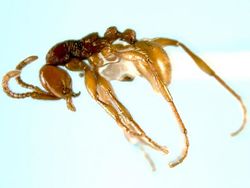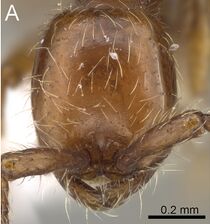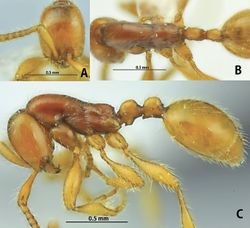Key to southeastern Asian Aenictus ceylonicus group species
Key to Asian Aenictus ceylonicus group species based on workers, modified from Jaitrong & Yamane (2013), Liu et al. (2015) and Staab (2015) by Dhadwal & Bharti (2023).
1
- Mandible with 2-6 teeth/denticles between subapical and basal teeth (mandible with more than 4 teeth/denticles) (Fig. 5a) => 2
- Mandible with 0-1 tooth/denticle between subapical and basal teeth (mandible with 3-4 teeth/denticles) (Fig. 5b) => 22
2
return to couplet #1
- Promesonotum entirely sculptured (punctate or reticulate) => 3
- Promesonotum largely smooth and shiny => 4
3
return to couplet #2
- Promesonotum sparsely reticulate or superficially micropunctate; antennal scape superficially shagreened; petiole cylindrical, clearly longer than high (Fig. 6a) => Aenictus cylindripetiolus
- Promesonotum densely punctate; antennal scape micropunctate; petiole round or subangular, almost as long as high (Fig. 6b) => Aenictus thailandianus
4
return to couplet #2
5
return to couplet #4
- Dorsum of mesonotum and petiole finely reticulate => 6
- Dorsum of mesonotum and petiole smooth and shiny => 7
6
return to couplet #5
- Subpetiolar process rectangular-trapezoidal, its ventral outline with a thin almost transparent lamellae (Fig. 7a); masticatory margin of mandible with 4 (rarely 3) denticles (total number of mandibular teeth 6-7, including apical, subapical, and basal tooth) => Aenictus hoelldobleri
- Subpetiolar process rectangular, its apex very acute and directed downwards medially (Fig. 7b); masticatory margin of mandible with 6 denticles (total number of mandibular teeth 9 including apical, subapical, and basal tooth) => Aenictus wudangshanensis
7
return to couplet #5
- Metanotal groove distinct; lateral propodeal margins converge more sharply posterad; pospetiole convex in profile; subpetiolar process subrectangular with acute anterior corners and blunt posterior corners (Fig. 8a, b) => Aenictus dirangensis
- Metanotal groove weakly impressed; lateral propodeal margins gently sloping posteriorly; pospetiole angular in profile; subpetiolar process relatively elongated, and slightly projecting anteroventrally (Fig. 8c, d) => Aenictus yangi
8
return to couplet #4
- Dorsal face of propodeum mostly smooth and shiny, the lateral face of propodeum partly smooth and shiny; postpetiole entirely smooth and shiny (Fig. 9a) => 9
- Propodeum entirely sculptured; postpetiole entirely sculptured or with a smooth and shiny small area on the dorsal face (Fig. 9b) => 12
9
return to couplet #8
- The declivity of propodeum with lateral carinae, but not demarcated basally by a transverse carina (Fig. 10a) => Aenictus longicephalus
- The declivity of propodeum is shallowly concave, encircled with a rim (Fig. 10b) => 10
10
return to couplet #9
- Distal 2/3 of basal margin of mandible straight, proximal 1/3 narrowed toward the base of mandible; anterior clypeal margin straight; petiole smaller than postpetiole (Fig. 11a, b) => Aenictus minipetiolus
- Basal margin of mandible feebly concave; anterior clypeal margin concave; petiole larger than or as large as postpetiole (Fig. 11c, d) => 11
11
return to couplet #10
- Promesonotum is strongly convex and sloping gradually to the metanotal groove; subpetiolar process with angular posteroventral corner (Fig. 12a) => Aenictus baliensis
- Mesosoma almost flat dorsally or feebly convex; subpetiolar process lower, with its posteroventral corner rounded (Fig.12b) => Aenictus wiwatwitayai
12
return to couplet #8
- Vertex with sparse standing hairs and with a few short appressed hairs; promesonotum with few appressed hairs and a few decumbent hairs (Fig. 13a) => 13
- Vertex and promesonotum with dense standing or decumbent hairs (Fig. 13b) => 14
13
return to couplet #12
- Vertex with two long-standing hairs mixed with a few short appressed hairs => Aenictus appressipilosus
- Vertex with only few short appressed hairs => Aenictus malakkaparensis
14
return to couplet #12
- Occipital corner modified into a small lobe in profile and dorsal view (Fig. 14a) => Aenictus gonioccipus
- Occipital corner without modifications in profile and dorsal view (Fig. 14b) => 15
15
return to couplet #14
- Mesonotum straight in dorsally slope down backward; posterodorsal corners of propodeum protruding and dentate, declivity concave => Aenictus henanensis
- Mesonotum weakly or strongly convex in dorsal outline; posterodorsal corners of propodeum angular nearly right-angled, declivity shallowly concave => 16
16
return to couplet #15
- Masticatory margin of mandible with large acute apical tooth followed by a series of 6-7 denticles of two sizes, the larger alternating with 1-2 smaller; the gap between anterior clypeal margin and mandibles relatively small or indistinct, with maximum width shorter than the maximum width of the mandible (Fig. 15a) => Aenictus lifuiae
- Masticatory margin of mandible with large acute apical tooth followed by a medium-sized subapical tooth, 2-5 denticles, and a medium-sized basal tooth; the gap between anterior clypeal margin and mandibles relatively large and distinct, with maximum width longer than the maximum width of the mandible (Fig. 15b) => 17
17
return to couplet #16
- Subpetiolar process subtriangular, its apex directed backward, anteroventrally not angular; postpetiole elevated posteriorly; its posterior face much steeper than anterior face (Sumatra) (Fig. 16a) => Aenictus itoi
- Subpetiolar process subrectangular, its apex directed forward , anteroventrally angular; postpetiole with roundly convex dorsal outline (Fig.16b, c) => 18
18
return to couplet #17
- Subpetiolar process rectangular, ventrally with anterior and posterior corners => 19
- Subpetiolar process low, its ventral outline convex, almost straight or feebly concave, and anteroventral corner acutely angular => 21
19
return to couplet #18
- Dorsal outline of propodeum weakly convex; metapleural gland bulla weakly sculptured (Vietnam) => Aenictus eguchii
- Dorsal outline of propodeum straight; metapleural gland bulla strongly sculptured (puncto-reticulate) => 20
20
return to couplet #19
- Posteroventral corner of subpetiolar process angular (not spiniform) => Aenictus kodungallurensis
- Posteroventral corner of subpetiolar process acutely produced ventrally (spiniform) => Aenictus jawadwipa
21
return to couplet #18
- Promesonotum in profile weakly convex; propodeal dorsum feebly convex; petiole sessile, its posterior face encircled with a thin carina; postpetiole almost as long as petiole (Fig. 17a) => Aenictus wilaiae
- Promesonotum in profile strongly convex and forming a dome; propodeal dorsum clearly straight; petiole subsessile, its posterior face not encircled with a carina; postpetiole slightly shorter than petiole (Philippines) (Fig. 17b) => Aenictus pilosus
22
return to couplet #1
- Mandible with 3 teeth including apical and basal teeth (Fig. 18a) => 23
- Mandible with 4 teeth including apical and basal teeth (Fig. 18b) => 24
23
return to couplet #22
- Occipital corner rounded in lateral view; promesonotum in profile strongly convex and forming a dome; petiole almost as long as high, with high node, and almost as long as postpetiole (Fig. 19a) => Aenictus watanasiti
- Occipital corner shallowly rounded in lateral view; promesonotum in profile with weakly convex or almost flat dorsal outline; petiole clearly longer than high, with low node, and slightly longer than postpetiole Fig. 19b) => Aenictus concavus
24
return to couplet #22
- Dorsal and lateral faces of pronotum largely smooth and shiny; petiole almost as long as high; head slightly longer than or almost as long as broad (CI 90- 100) (Fig. 20a) => 25
- Dorsal and lateral faces of pronotum entirely sculptured (superficially puncto-reticulate, punctate to reticulate); petiole cylindrical, distinctly longer than high; head slightly shorter than broad (CI 102-112) (Fig. 20b) => 27
25
return to couplet #24
- Anterior clypeal margin distinctly concave; metanotal groove distinct, deep; foretibia relatively short, its length less than 0.5 times of head width; mesopleuron finely punctate without longitudinal rugulae (Fig. 21a) => Aenictus brevipodus
- Anterior clypeal margin almost straight or feebly concave; metanotal groove indistinct; foretibia relatively long, its length about 0.9-1.0 times as long as head width; mesopleuron with longitudinal rugulae (Fig. 21b) => 26
26
return to couplet #25
- Subpetiolar process low, ventral outline weakly convex, its anteroventral corner angular (Thailand) (Fig. 22a) => Aenictus khaoyaiensis
- Subpetiolar process well-developed, subrectangular with a convex ventral lamella, with anterior corners acute and posterior corners bluntly angular (Fig. 22b) => Aenictus formosensis
27
return to couplet #24
- Subpetiolar process very low, with anterior and posterior denticles that protrude anteroventrally; head in full-face view rectangular, its posterior margin feebly concave (Thailand) (Fig. 23a, b) => Aenictus maneerati
- Subpetiolar process subrectangular or low, with its anteroventral corner acutely angular and ventral outline straight or convex; head in full-face view subrectangular or rounded, its posterior margin weakly concave, almost straight or weakly convex (Fig. 23c, d) => 28
28
return to couplet #27
- Pronotum with central area superficially shagreened or rather smooth and shining, and with lateral face reticulate and shiny; subpetiolar process low, with its anteroventral corner acutely angular and ventral outline concave (Fig. 24a) => Aenictus sundalandensis
- Pronotum micropunctate or reticulate and opaque (at most weakly shining); subpetiolar process always low, with its anteroventral corner acutely angular and ventral outline almost straight or convex (Fig. 24b) => 29
29
return to couplet #28
- Pronotum entirely strongly punctate (N. Thailand) (Fig. 25a) => Aenictus pinkaewi
- Anterior portion of the pronotum densely punctate, the lateral face of the pronotum finely reticulate (China, Hong Kong, Laos and Thailand) (Fig. 25b) => Aenictus fuchuanensis
References
- Dhadwal, T., Bharti, H. 2023. Aenictus dirangensis sp. nov. (Hymenoptera: Formicidae), a new species of Aenictus ceylonicus group from India. Journal of the Entomological Research Society 25(2): 387-403 (doi:10.51963/jers.v25i2.2367).
- Jaitrong, W., Yamane, S. 2013. The Aenictus ceylonicus species group (Hymenoptera, Formicidae, Aenictinae) from Southeast Asia. Journal of Hymenoptera Research 31: 165-233 (doi:10.3897/jhr.31.4274).
- Liu C, Hita Garcia F, Peng Y-Q, Economo EP (2015) Aenictus yangi sp. n. – a new species of the A. ceylonicus species group (Hymenoptera, Formicidae, Dorylinae) from Yunnan, China. Journal of Hymenoptera Research 42: 33–45 (doi:10.3897/JHR.42.8859).
- Staab M (2015) Aenictus hoelldobleri sp. n., a new species of the Aenictus ceylonicus group (Hymenoptera, Formicidae) from China, with a key to the Chinese members of the group. ZooKeys 516: 137–155 (doi:10.3897/zookeys.516.9927).






























































